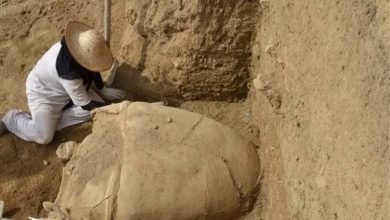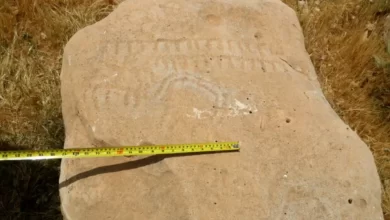Coronavirus in Iran: too little, too late
US, WASHINGTON (ORDO NEWS) — After the United States, Spain, Italy and China, Iran is a center of the corona virus and the frontrunner in the Middle East. But the leadership prefers to disguise the scale of the crisis rather than responding to it appropriately, reports ARD correspondent Natalie Amiri from Tehran.
The living room of Mariam and her husband would normally be full of frolicking children and laughing grandparents who are handing over money to their grandchildren to celebrate the Iranian New Year Nowruz. But this year, the two of them are sitting at home alone in the Iranian provincial city of Yazd, about 630 kilometers south of Tehran, in front of their Sin prison - a table that is set with seven symbolic components. Seven things that start with S like Sonbol (hyacinth - stands for friendship) or Serke (vinegar - stands for patience), which should bring confidence, happiness, joy and health in the new year.
File ReutersMariam and her husband are scared. They do not want to be identified for fear of repression. We reach the couple via WhatsApp: “The state informs us far too little,” says Mariam. “There are no adequate measures. There are no clear rules of conduct. Otherwise the rulers here have no inhibitions to restrict our freedom, but now, when it comes to life and death, instructions were far too late that people should stay at home.”
On April 1, Sizdah is needed, the thirteenth day in the new calendar year. It is customary on this day for people to go outside and picnic. Nothing will come of it. Iranian President Rouhani announced on March 25 that all parks would be closed. Far too late, many in the country criticize.
Iran is after the United States, Spain, Italy and China with currently 41,495 infected and 2,757 deaths a center of coronavirus and leaders in the Middle East. Over a hundred dead are officially admitted every day, and it has been going on for weeks. The Ministry of Health has been publishing new figures once a day in a press conference since the end of February. Many doubt these numbers. Corona cases were officially mentioned for the first time on February 19. Two people tested positive that day in the religious city of Qom, it said. The Ministry of Health admitted her death later that day.
The origin of the outbreak of the corona epidemic in Iran is in Qom. The “holy city” is a pilgrimage destination for millions of believers every year. Around 700 Chinese students attend lectures on Shiite theology. It is said that the virus came from China to Iran. Iran’s relationship with China has long been close, and western sanctions have promoted it. Iranian dealers filled the flights of the Iranian airline Mahan, which flew to Chinese airports several times a week.
File ReutersAlready in January one heard of overcrowded hospitals and overcrowded medical practices in Qom. They all struggled with a wave of patients with the same symptoms: shortness of breath, coughing cough, fever. The regime dismissed information about the dramatic situation in the religious city as “fake news” from abroad. The virus had most likely been in Qom since early January. However, it was only on March 16 that the religious shrines were closed by the state. On March 16, the transport minister announced that the flights to China would only be carried out as air freight flights without passengers.
The population was not informed
Not only was the virus early in the country, the knowledge of its dangerousness. It was suppressed for political reasons. At the beginning of January, the senior nurse Sadaf P. noticed in the Day Hospital in Tehran that more and more patients were admitted with similar symptoms. On the phone, she now describes how she witnessed the Corona outbreak early on. She also wants to be anonymized for her own protection. She reports how the Iranian Ministry of Health sent a circular to her hospital in early January that she received initial general information about a virus called Covid-19.
The day hospital evacuated the intensive care unit for children in the middle of the month, it was used for patients who were getting more every day. Your symptoms: shortness of breath, irritable cough, fever. Sadaf P. noticed that this is not a normal development. The Ministry of Health then continued to provide information to the hospitals by email. Confidential. The Day Hospital in Tehran was also informed. Not the population.
File ReutersThis is how it works in a country where there is no free media, to which documents could be leaked if politics wants to cover up something. The regime has been in a threatening crisis of confidence since government agencies denied the shooting down of a Ukrainian passenger plane with 176 occupants for three days in January.
One could therefore assume that many citizens would not vote on February 21 to express their protest.
The Islamic Republic has no free elections, which is why, paradoxically, high turnout is important to legitimize the regime. Information about a highly contagious virus circulating in the country came in very badly.
This held back what had long been known about the new virus. The elections were held. Voter turnout was lower than ever before - but shortly afterwards, the number of people admitted to hospital with symptoms of Covid-19 skyrocketed.
The biggest problem is early detection
Government spokesman Ali Rabiei holds a press conference on February 24. The deputy minister of health stands next to him. While the government spokesman says the virus is under control, the deputy health minister is dripping sweat. He wipes his wet face with paper towels several times. A day later, he announced on Twitter that he was infected with the coronavirus. He is not the only one: high-ranking politicians, members of the Revolutionary Guard, close advisers to revolutionary leader Ali Khamenei have become infected. Over a hundred senior officials have died as a result.
On March 25, a month after the Iranian government spokesman announced that the virus was under control, Lothar Wieler, President of the Robert Koch Institute, announced in his daily press conference on Iranian television that the number of infections for Iran was 23,049, 1,411 more than the previous day. The death rate is 7.9 percent. Wieler emphasizes that these are the “official figures”.
File ReutersThe real numbers in Iran are said to be five times higher. WHO Middle East emergency officer Rick Brennan, who traveled to the Islamic Republic with a delegation in early March (March 2-11), believes the number of unreported cases is enormous. Iranian MPs are now saying openly that they believe the official figures are far understated.
The high death rate in Iran - between eight and eighteen percent - is due to who is being tested in Iran, according to an insider from the Iranian health system. Test kits are only available in hospitals, tests are only carried out there. But only those who already suffer from life-threatening shortness of breath come to the hospital. Patients who are admitted to Iran say goodbye to relatives beforehand because they are afraid that they will no longer come out of the hospital alive.
The biggest problem in Iran is early detection, according to the insider. “You missed the beginning of the epidemic.” In Iran, contacts of infected people have never been tested. And the infected people are only taken to the hospital when it is actually too late.
Mass graves are being excavated
On March 17, the New York Times released satellite images from Qom in early March. On them you can see that mass graves were apparently excavated there . The Islamic Republic denies this news. Islam prescribes a burial within 24 hours. If one assumes the unofficial number of deaths, this can hardly take place without mass burials.
Private hospitals like the Day Hospital in Tehran have long since stopped admitting corona patients.
The condition in the state hospitals is catastrophic. The onslaught is hardly manageable. The military is now building temporary field hospitals, parking lots and shopping centers have to serve. There are not enough protective masks, gloves, hygiene products, respirators. More than 40 doctors and nurses have died of Corona.
File AFPIran has 63 medical universities. The country has excellent doctors, but not enough equipment. Domestic production for medical equipment was started. Iran now produces disinfectants and protective masks itself in the chord. 70 percent of healthcare equipment is produced in Iran due to harsh sanctions.
The 30 percent that are urgently needed from abroad hardly arrive. It is also about goods that are not directly affected by sanctions.
The lack of transparency in the network of sanctions makes foreign producers shy away from delivering to Iran.
Who should still believe the official numbers?
An example: Iran urgently needs more test kits. A Berlin company that produces them is willing to deliver them. But your product can also be used to test for the older SARS virus. This in turn is on the list of bioweapons, which is why the tests fall under the dual-use goods prohibited by sanctions (which can be used both civilly and militarily) and must not be exported. The Berlin-based company has now received an exemption from the Federal Office of Economics and Export Control (BAFA) “according to a cursory check”. Nonetheless, the uncertainty remains of being jailed in Iran for doing business of this kind.
“International solidarity is needed in Corona times.” Over 300 Iranian artists appeal to the world for help. They ask that the sanctions be lifted in these difficult times. The Iranian Foreign Minister has posted a list of medical equipment that Iran desperately needs on Twitter. At the same time, for the first time in nearly 60 years, Iran asked the International Monetary Fund (IMF) for help on March 12 and requested $ 5 billion to be released. The IMF has not yet commented on this.
US President Donald Trump offered humanitarian aid to Iran in late February, albeit without concrete proposals. Revolutionary leader Khamenei dampened the offer of help by saying in a speech on state television that he had heard that the US had launched the virus itself and only wanted to get an idea of how successful the virus was in Iran.
File ReutersA MSF delegation that had already landed in Iran on a charter plane full of medical equipment was turned away and had to turn around. Such decisions by the Iranian government raise suspicions that the Islamic Republic wants to use the epidemic to get aid and to ease the sanctions. The regime’s survival interest was above the fight against the virus.
Whoever criticizes will be picked up
Mariam in the provincial city of Yazd knows that from this Saturday onwards the year after the holidays will start in Iran. Schools, universities, shops, politics would go back to work. But how does the government decide? The country cannot afford a total lockdown economically. “We can only dream of financial support programs like in Germany,” says Mariam.
The government’s aid program gives small earners a loan of the equivalent of 120 euros, with four percent interest. Unemployed people get vouchers worth 15 euros a month. Large companies have been promised tax cuts. All of this is not enough, and yet the economically desolate state cannot even afford these measures.
File AFPThe Iranian Ministry of Health claims the peak of the first epidemic wave will be reached in 19 days. But who should believe the official numbers? Anyone who disseminates numbers on the social networks that deviate from the official ones, or who has the slightest criticism of the government’s crisis management, will be picked up by the Iranian secret service.
Mariam clears her Haft Sin table. “The whole world is affected by this virus, everyone is afraid. It connects us to the rest of the world. But we have an inadequate health system, we are subject to sanctions like no other country in the world and are governed by politicians who don’t want our best, but only have their own good in mind.”
The grass basket in which Mariam sprouted wheat germ for the Persian New Year is on the table as a symbol of liveliness. It is thrown into a river on the 13th day of the new year according to old custom. Before that, everyone in the family ties one of the blades of grass and wishes something for the New Year.
This year the grass ends up in the trash can. Without knots.
—
Online:
Our Standards, Terms of Use: Standard Terms And Conditions.
Contact us: [email protected]
The article is written and prepared by our foreign editors from different countries around the world - material edited and published by Ordo News staff in our US newsroom press.








